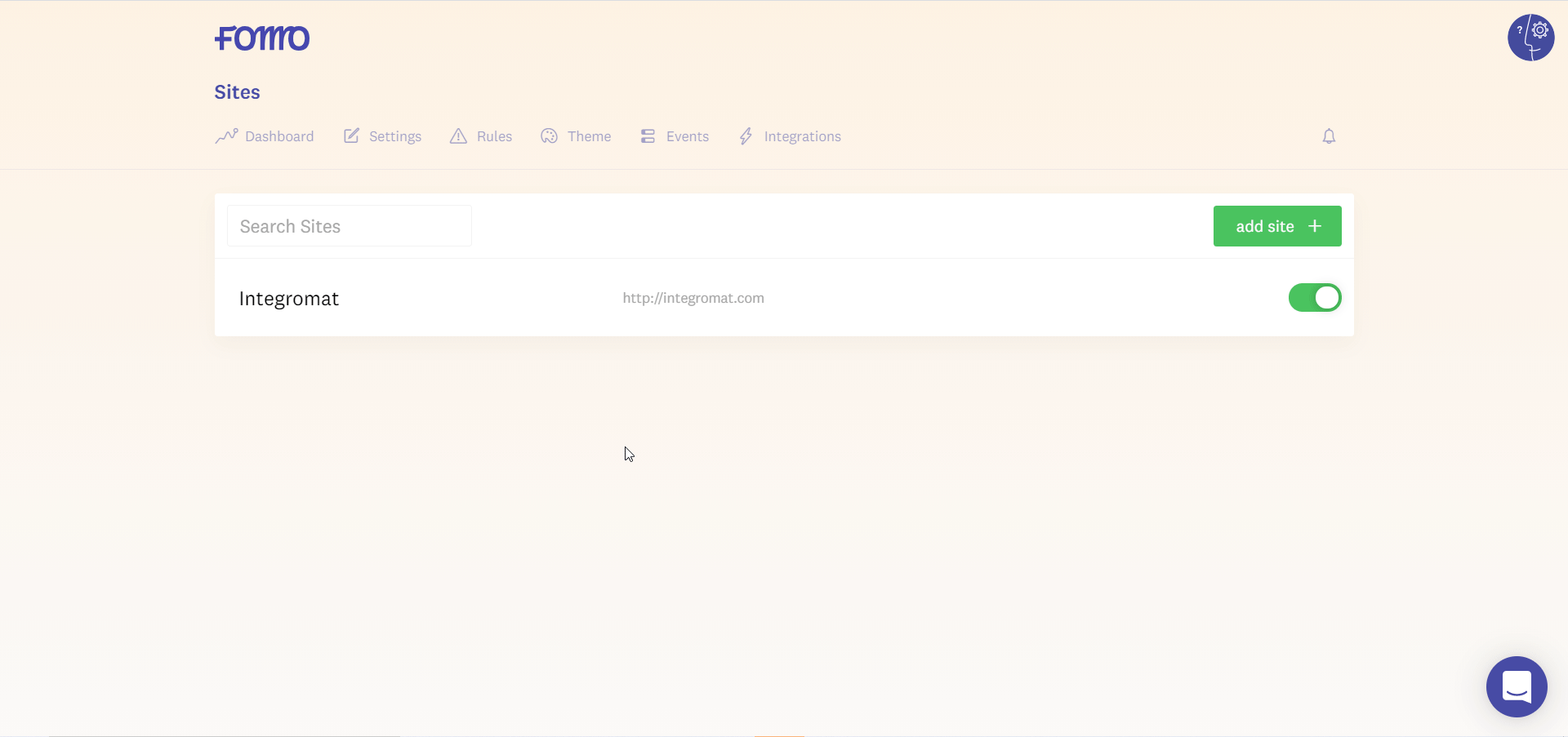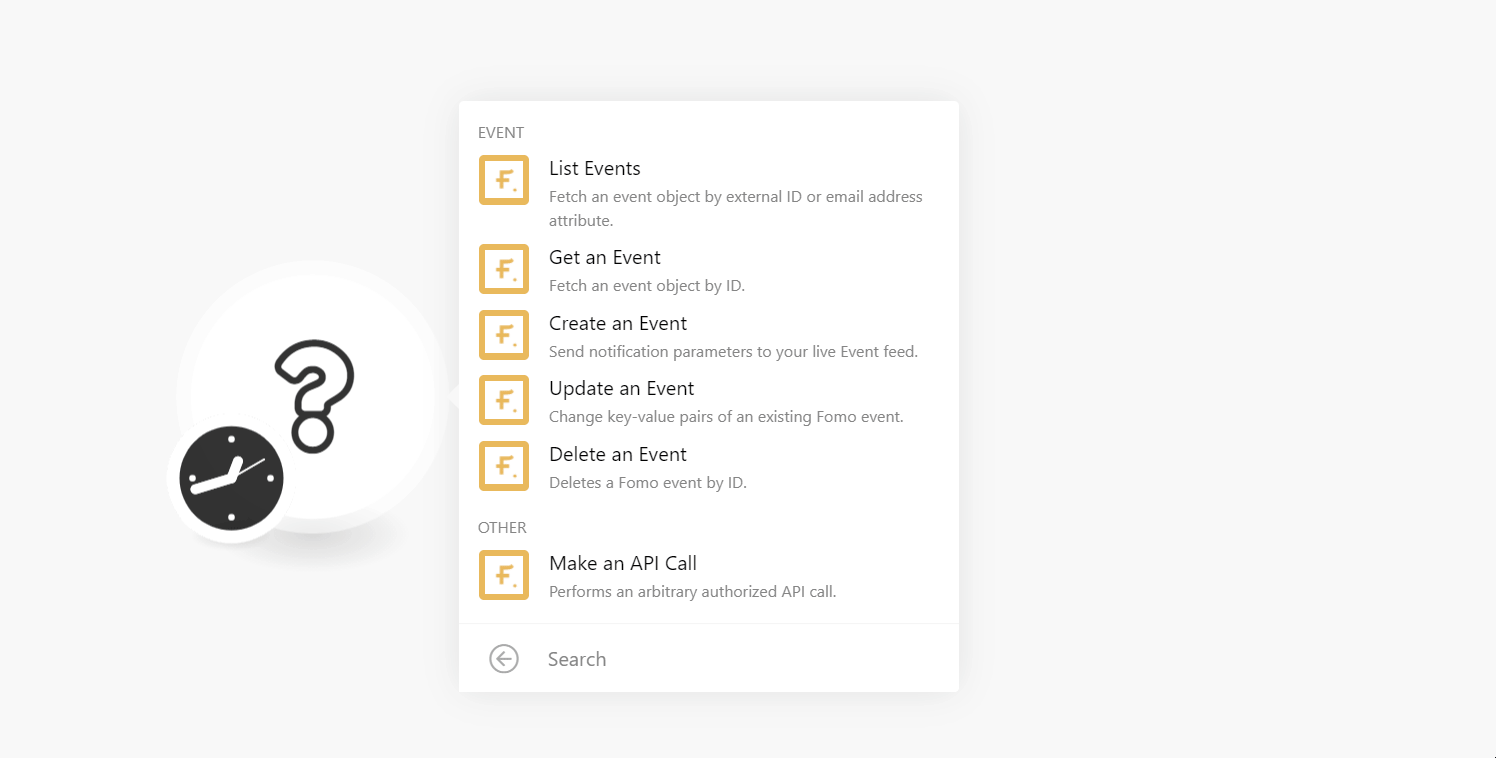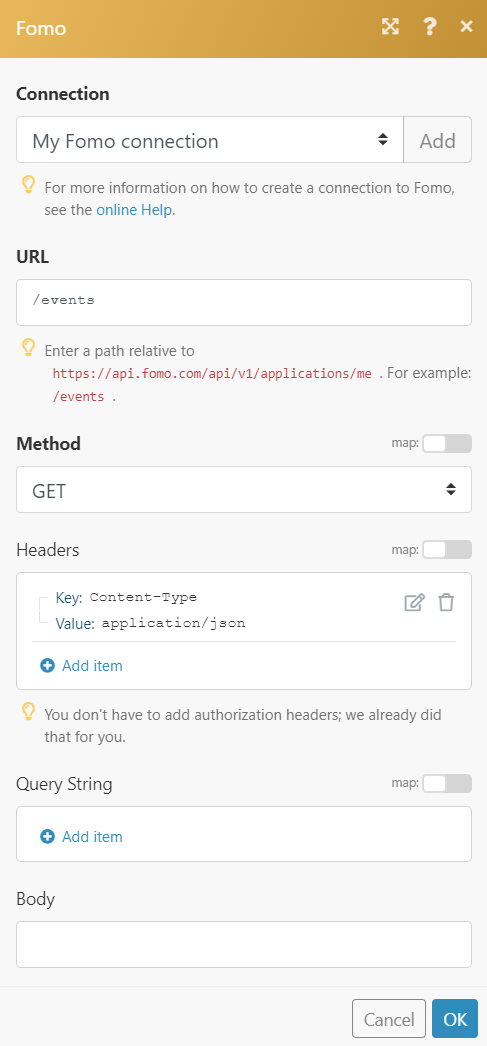The Fomo modules allow you to create, update, list, retrieve, and delete the events in your Fomo account.
Prerequisites
-
A Fomo account
In order to use Fomo with Boost.space Integrator, it is necessary to have a Fomo account. If you do not have one, you can create a Fomo account at fomo.com/register.
![[Note]](https://docs.boost.space/wp-content/themes/bsdocs/docs-parser/HTML/css/image/note.png) |
Note |
|---|---|
|
The module dialog fields that are displayed in bold (in the Boost.space Integrator scenario, not in this documentation article) are mandatory! |
To connect your Fomo account to Boost.space Integrator you need to obtain the API Key from your Fomo account and insert it in the Create a connection dialog in the Boost.space Integrator module.
-
Log in to your Fomo account.
-
Click the site for which you want to establish the connection > Settings.
-
Navigate to the Auth Token section and copy the token to your clipboard.
-
Go to Boost.space Integrator and open the Fomo module’s Create a connection dialog.
-
In the Connection name field, enter a name for the connection.
-
In the Token field, enter the auth token copied in step 3, and click Continue.
The connection has been established.
Fetch an event object by external ID or email address attribute.
|
Connection |
|
|
Limit |
Set the maximum number of events Boost.space Integrator will return during one scenario execution cycle. |
|
Order By |
Select whether you want to sort the events by created at or by Event Type ID. |
|
Order Direction |
Select the direction in which you want to list the events. For example, Asc for ascending and Desc for descending. |
Fetch an event object by ID.
|
Connection |
|
|
Event |
Select or map the event whose details you want to retrieve. |
Send notification parameters to your live Event feed.
|
Connection |
|
|
Template |
Select or map the template for the event you want to create. |
|
External ID |
Enter (map) the event’s External ID. |
|
First Name |
Enter (map) the person’s first name who is associated with the event. |
|
Email Address |
Enter (map) the person’s first name who is associated with the event. The email address is used to create dynamic customer avatars. The email address is never shown publicly. |
|
IP Address |
Enter (map) the person’s IP address. This information is used to extract city, province, and country parameters. |
|
City |
Enter (map) the city name where the event happened. |
|
Province |
Enter (map) the state or province where the event happened. |
|
Country |
Enter (map) the two-character country code where the event happened. For example, the US for the United States. |
|
Title |
Enter (map) the event name. For example, |
|
URL |
Enter (map) the URL address to redirect the user when they click the event. |
|
Image URL |
Enter (map) the URL address of the image to be displayed for the event. |
|
Custom Event Fields Attributes |
Enter the customer event fields and their values. For example, |
Change key-value pairs of an existing Fomo event.
|
Connection |
|
|
Event ID |
Select or map the Event ID whose details you want to update. |
|
Template |
Select or map the template for the event you want to create. |
|
External ID |
Enter (map) the event’s External ID. |
|
First Name |
Enter (map) the person’s first name who is associated with the event. |
|
Email Address |
Enter (map) the person’s first name who is associated with the event. The email address is used to create dynamic customer avatars. Never shown publicly. |
|
IP Address |
Enter (map) the person’s IP address. This information is used to extract city, province, and country parameters. |
|
City |
Enter (map) the city name where the event happened. |
|
Province |
Enter (map) the state or province where the event happened. |
|
Country |
Enter (map) the two-character country code where the event happened. For example, the US for the United States. |
|
Title |
Enter (map) the event name. For example, |
|
URL |
Enter (map) the URL address to redirect the user when they click the event. |
|
Image URL |
Enter (map) the URL address of the image to be displayed for the event. |
|
Custom Event Fields Attributes |
Enter the customer event fields and their values. For example, |
Deletes a Fomo event by ID.
|
Connection |
|
|
Event |
Select or map the event you want to delete. |
Performs an arbitrary authorized API call.
|
Connection |
||||
|
URL |
Enter a path relative to
|
|||
|
Method |
Select the HTTP method you want to use: GET to retrieve information for an entry. POST to create a new entry. PUT to update/replace an existing entry. PATCH to make a partial entry update. DELETE to delete an entry. |
|||
|
Headers |
Enter the desired request headers. You don’t have to add authorization headers; we already did that for you. |
|||
|
Query String |
Enter the request query string. |
|||
|
Body |
Enter the body content for your API call. |



